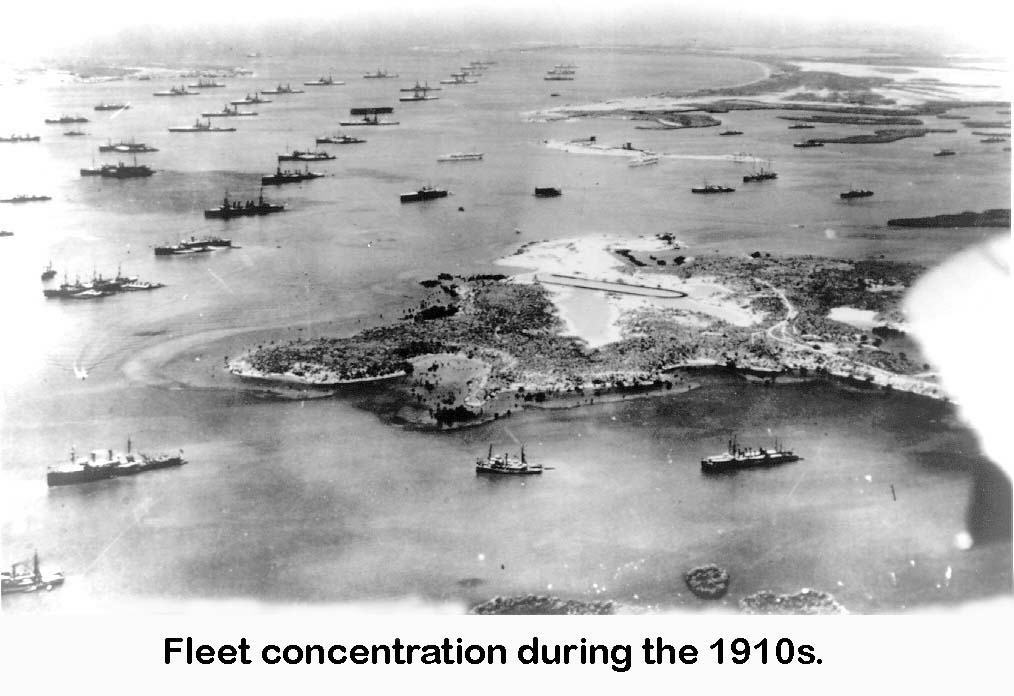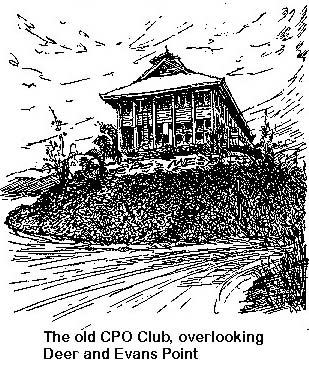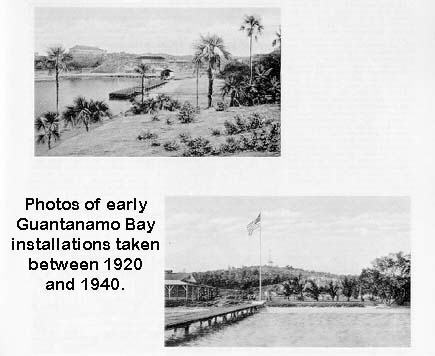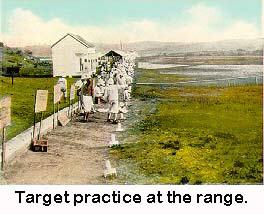CHAPTER V
NAVAL STATION RELOCATED AND BUILT UP
The year 1909 found the station at its lowest ebb while future policy for its use was being studied by the Navy Department and Congress. Difficulties of obtaining appropriations for further development accentuated the problem. Late in 1910, anothcr survey of the station was ordered for the purpose of finding the most economical site for the installation of a floating dry dock. Corinaso Cove, which at the time extended from Corinaso Point to what is now Radio Point, was selected as the best location because it offered greater protection from enemy action. In 1911 work was begun in the vicinity of what is now wharf Baker and the construction of a power plant, a wooden pier, machine shop, woodworking shop, store houses, storage tanks, quarters, etc., was started on the new location. This new location was to be called for many years the "Main Station".
Lieutenant Commander Walter Ball (November 1909 - January 1912) was Commandant during this turn of events. He is reputed to have disliked living ashore (wherever it was!) and to have taken up quarters on the USS Vixen where he lived during his tour of duty. The Vixen had apparently relieved thd Newark as station ship. No doubt his living on the Vixen put him closer to the new construction work in Corinaso Cove than would have quarters on Toro Cay or other distant location.

In early 1910 the Atlantic Fleet, including the Minnesota, New Hampshire, Missouri, the Idaho, and many other ships, had a fleet concentration in Guantanamo Bay. There is an old photograph showing in panoramic view the Second Regiment, U. S. Atlantic Fleet, encamped as a landing force on Deer Point, under date of 13 February 1910. About 20 ships can be seen anchored in the background. The picture was apparently taken from a point in the vicinity of the present CPO Club, and is a most interesting scene.
From time to time after the Spanish-American War Marine units of varying sizes, in addition to Marine garrison forces, have been sent to Guantanamo Bay for specific tasks, the first having been in October 1906. In early days these tasks were associated with the political disturbances and revolutions which from time to time harassed Cuba, and which invited U.S. intervention under the terms of the Platt Amendment. Among these political disturbances was the race war of 1912. This was a Negro uprising in Oriente, which however was quickly suppressed, but not before a body of U. S. Marines had landed for the protection of foreign nationals and their property.
Happy Valley
At about the time the Main Station was being built up, oil as propulsion fuel began to take on importance. To provide for future fueling requirements of the Fleet, a battery of seven tanks was constructed in 1913 at a place to be later known as Happy Valley. The total capacity of the tanks was 215,000 barrels. These tanks were connected with pipe lines to an oil fueling pier (Pier C) at Corinaso Cove.
The first magazine was built on the station in 1913. This magazine, long since abandoned as such is now known as building 200. It and the accompanying shell house, now building 201, are of permanent construction. A fresh water tank (No. 38) was erected in 1913 up the hill from the Main Station. The Naval Dispensary was moved from South Toro to its permanent location on Upper Flats, now known as Hospital Point. It consisted of only one building. An officers' clubhouse was constructed on the tip of Evans Point. A new Radio Station was built on Radio Point, with two tall towers which were to be prominent in the station's sky-line for the next forty years.
The winter of 1913 saw the first appearance of submarines at Guantanamo (also of aircraft, discussed elsewhere). Lieutenant (later Fleet Admiral) C. W. Nimitz, was in command of the submarine group, which consisted of two tenders and five submarines.
Captain George W. Kline, was Commandant from January 1912 to June 1913. Lieutenant Merrit S. Corning was Acting Commandant from June 1913 to January 1914, and was in addition commanding officer of the USS Cumberland, an old square rigged sailing ship stationed at Guantanamo Bay. The years 1912 to 1914 were important years in the development of the Main Station, the area which is now the Industrial area of the Base. The construction and Repair Department (later called the Ship's Repair Department) was moved from Hospital Cay to this area. This department, consisting of two divisions, Hull and Machinery, had offices and various shops-blacksmith, paint, machine, and carpenter-and a marine railway. Activities began functioning in this locality as an emergency repair and docking station on 15 October 1913. On 10 December 1913 official operations began and the flag was raised on the new station, marking the complete removal of station activities from the old station on South Toro Cay.
Unpleasant Episode
An unpleasant episode of this time is related by Commodore Dudley W. Knox. As a Commander he was serving afloat in early 1914 with units of the fleet visiting Guantanamo. He was made Judge Advocate of a Court of Inquiry of which Rear Admiral W.S. Sims was President, to investigate charges concerning Lieutenant Corning's conduct and sobriety during the time he was serving as Acting Commandant. Apparently what gave the matter official attention and brought on the investigation was a gun salute fired by the station ship to Lieutenant Corning in the middle of the night, following a party in his honor. Commodore Knox's memory fails as to details, but he knows that Lieutenant Corning left the naval service as a result of the inquiry. Records indicate that he was separated from the service on 2 April 1914 and died shortly thereafter, 8 July 1914.
By the end of 1914 six storehouses for supply were constructed in the Industrial Area. These buildings provided 30,000 square feet of storage space including office space for supply and disbursing functions.
Lieutenant Commander Hilary Williams had a short tour of duty as Commandant from January to October 1914. He was followed by Commander John H. Luby from December 1914 to May 1916. Commander Dudley W. Knox relieved him in May 1916 and served until September 1917. Commander Knox was later to win considerable renown as a Naval writer. He is still living (1952) and a Commodore on the retired list. Mrs. Knox was the daughter of Rear Admiral Bowman H. McCalla for whom McCalla hill is named.
Upper Flats
By 1916 most of the officers and civilian quarters had been completed on Upper Flats, now known as Hospital Point. The Commandant lived in quarters A, the first to be built (1913). (Quarters A was torn down in 1950). An old landmark, the Enlisted Men's Recreation Building (now thw Chief Petty Officers' Club) was built in 1916-for long the most prominent building on the station because of its situation on the hill overlooking Deer Point and the Fleet Landing.

A barracks building and a mess hall were constructed on Corinaso Point during Commander Knox's time, about the year 1917. These were to accommodate 250 men, more than the station complement of about 200. Previously these men had been quartered and messed afloat, specifically on board the gunboat Petrel, and also on barges.
Of some interest was a vegetable farm started by Commander Knox in Cuzco Valley, near the present Naval cemetary. Wells were dug and plenty of water obtained for irrigation, but it was a little brackish and hence not potable. A windmill was used to pump the water. The vegetables produced added much to the life of the station.
Another Revolution
Shortly before our entrance into World War I, another civil war in Cuba occupied the attention of the Station and particularly its Commandant, at least for a brief period. This civil war grew out of the campaign and national election of 1916, and a dispute as to who won. President Menocal and Alfredo Zayas of the Liberal party were the candidates. The Liberals revolted. Santiago fell to the revolutionists on 13 February 1917, and three Cuban gunboats appeared the next day in Guantanamo Bay, having left Santiago to escape capture. The American Consul at Santiago requested the presence of a U.S. man-of-war to maintain communications and allay excitement of the populace, his request arriving at about the same time as information that the Revolutionists were intending to mine the mouth of Santiago Bay. The Commandant volunteered the services of the station ship Petrel, an old gunboat. The Petrel was in poor shape and a feeble show of power, but she was readied and departed for Santiago with Commander Knox aboard. The experiences of Commander Knox at Santiago are a rather long and interesting story, as later narrated by him in an article entitled "An Adventure in Diplomacy" which appeared in the February 1926 issue of the Naval Institute Proceedings. He became the "go-between" in dealings between the Fcdcrals and Revolutionists, and was able to dissuade the latter from blocking and mining the channel; and the former, from attacking from sea with their gunboats. That the mines were poor in quality and would not have been a serious menance to shipping, and furthermore, that the Cuban gunboats were not much of a threat to Santiago, were not recognized at the time. Anyhow the people of Santiago, were delighted with the temporary neutralization of the area. In his negotiations, Commander Knox had to exceed his radio instructions from the Commander-in-Chief of the Atiantic Fleet, and from Washington, and there were anxious moments, but his actions were later sustained. The Petrel was soon relieved by a larger ship, and returned to Guantanamo Bay with the Commandant.
U.S. Marines were landed at Santiago to aid in the preservation of order. Also records indicate an expeditionary force of about 100 Marines of the 51st Company under First Lieutenant Lloyd W. Williams was based at Guantanamo Bay from 4 March to 23 May 1917. Fortunately, the revolution was short-lived; the Liberals were defeated; and President Menocal entered upon his second term in May 1917.
Growing Pains
Turning again to conditions at the Bay, the Station had shaken down in its new location, but not without growing pains. Apparently there were cliques and resultant friction from time to time among families in the small Naval community. Commdore Knox in later years relates that he was able to eliminate much of this while he was Commandant, at least for the time being.
Commander Knox became ill and had to be evacuated to the States in September 1917. He left by rail and was taken up through Havana. He was relieved by Commodore E.E. Wright (Ret) who served during the period September 1917-November 1918, most of the
war period.
World War I found the Naval Station relatively unprepared to meet a wartime emergency. After the United States entered the war in April 1917, appropriations were granted to increase fleet facilities for additional fuel oil ard water storage, and other buildings. However, these facilities were not completed until 1918 and by that time World War I was practically at an end. Therefore these added improvements and equipment contributed little to the war effort. The station's principal contribution has been the coaling of ships at Hospital Cay. It was very active in this respect.
Commander Guy Whitlock relieved Commodore Wright in December 1918. During the latter part of his tour of duty Commander Whitlock became mentally ill. In September 1920 he had to be relieved and transferred to Saint Elizabeth's Hospital, where he died some two years later.
20 Years of Normalcy
About the year 1919, the Naval Station reached a stage in its development that was little changed during the next twenty years. Most of the activities were on the Main Station, these activities comprising piers, ship repair, supply, ordnance, fueling, communications and medical to name a few. The Marines were located on Fisherman's Point. Navy barracks and messing facilities were on Corinaso Point. Radio Point was the center of communications activities. The Fleet Rifle Range, sprawled over a large area spreading out east abd southeast from the Fleet Landing, which was located then and now between Deer and Evans Points. There was still a coaling station on Hospital Cay.
There was still a coaling station on Hospital Cay.
The writer has a vivid recollection of coaling ships at Hospital Cay while visiting Guantanamo on midshipmen cruises. The first cruise was in 1919. In the next two decades he was here many times, twice again as a Midshipmen, and later as an officer during fleet concentrations in 1924, 1927, 1934, and 1939. He visited Guantanamo also on other occasions in the intervening years. During that time minor improvements and additions could be noted, but essentially the Naval Station remained the same in physical appearance from 1919 to 1939.

Go to Chapter Six